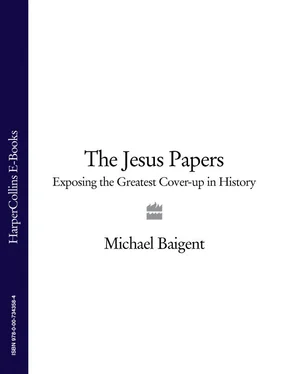As a Jew, Tiberius Alexander would have been well aware of the “Star” prophecy, so it is conceivable that he contrived to apply it to Vespasian. The Roman historian Dio Cassius reports that while Vespasian was in Alexandria he was said to have healed a blind man and another man with a crippled hand; both had been told in a dream to approach Vespasian. 9 Long ago, the great scholar Robert Eisler suggested that only Tiberius Alexander, with his knowledge of Jewish prophecy and his desire to see the triumph of Vespasian, would have thought to manipulate circumstances so that the prophecy of Isaiah would come true—the prophecy that states the day when God heals the earth, the day when “the eyes of the blind shall be opened, the ears of the deaf unsealed, then the lame shall leap like a deer” (Isaiah 35:5-6). Only Tiberius Alexander, Eisler noted, would have contrived to send the blind man and the cripple to Vespasian so that he could perform his “messianic miracle.” 10
Tiberius Alexander would also have been aware of another part of the prophecies of Isaiah—the destruction of the Temple in Jerusalem. Isaiah wrote that God said: “I will tell you what I am going to do to my vineyard…knock down its wall for it to be trampled on.” Two verses later, he explained, “Yes, the vineyard…is the House of David” (Isaiah 5:5, 7). For Tiberius Alexander, Vespasian was the messiah. Josephus agreed, writing, “In fact the oracle pointed to the accession of Vespasian.” 11 To both these Romanized Jews, Vespasian was the messiah who had been foretold long ago in their sacred scriptures. For both, the Line of David was as defunct as the Temple was soon to be.
Nevertheless, Vespasian must have felt that even if the prophecy were true, he had a shaky hold over the identification since he certainly hadn’t descended “from Jacob.” There was no blood from the Line of David coursing through his veins. So, after he had won the war and destroyed Jerusalem, he sought out all surviving members of the Line of David and executed them. Vespasian respected the power of the oracle and was not about to take any chances. He wanted “to ensure that no member of the royal house should be left among the Jews.” 12 But as history would later reveal, a number of the members of that ancient royal house had escaped his clutches.
With all this talk of stars, it is inevitable that we should address the Star of Bethlehem. The star is the messianic symbol of the Line of David. The Star of Bethlehem can also be termed “the Messiah of Bethlehem.” This would suggest that we need not look for astronomical supernovae or stellar conjunctions to explain the arrival of the Magi in Bethlehem, a stronghold of the Line of David. It was a matter of dynasty rather than astronomy. And the Magi knew where to go to find their king.
But there has always been a mystery over the story of Joseph and Mary taking the infant Jesus from Bethlehem to Egypt to escape Herod—as noted by Matthew. Luke explains that Jesus was born in Bethlehem, having been taken there as a member of the Line of David for the census. The only census known was that of Quirinius in A.D. 6, after Rome had taken over Judaea. But this is always thought of as too late for Jesus’s birth because the Gospels put him at around thirty years old at his crucifixion.
However, these calculations do not work very well and do not match the data given in the Gospels. Hugh Schonfield proposed a very provocative alternative.
The usual date for the crucifixion is given, with the Vatican’s imprimatur by a chronological table at the end of The Jerusalem Bible, as on the eve of the Passover, 8 April A.D. 30. 13 The reasoning is this: John’s Gospel contains some rather precise dating, citing the first Passover following Jesus’s baptism as that of A.D. 28 (John 2:13, 20). 14 John mentions two more Passovers, the third of which sees the crucifixion, which thus must have occurred before the Passover of A.D. 30. Can this be correct?
We have only two sources of hard data beyond the New Testament. First, Tacitus states that “Christ had been executed in Tiberius’ reign by the governor…Pontius Pilate.” 15 We know that Pilate was prefect of Judaea from A.D. 26 to 36, so that gives us a range within which we must stay. Second, although Josephus mentions the same incident, there is no general agreement that his passages mentioning Christ are original rather than later insertions by Christian editors.
The Gospel of Luke (3:1, 23) states that Jesus was about thirty years old at the time of his baptism by John, and this was after the fifteenth year of the reign of Tiberius (as calculated in Syria)—A.D. 27. But he was baptized not long before John the Baptist was executed, and after John’s death the Gospel of Matthew (14:13) describes Jesus as seeking refuge in the desert, perhaps fearing for his own life. What then was the date of the execution? It could not have been A.D. 27, for Matthew and Mark report that John the Baptist was arrested by Herod Antipas for criticizing his marriage to Herodias—the wife of his brother, whom she had divorced —a marriage outlawed by Jewish law and also by one of the texts of the Dead Sea Scrolls, the Temple Scroll. 16 Following this public criticism, John was executed. So far as can be ascertained, the marriage of Herod Antipas and Herodias took place in A.D. 35. Hence, John the Baptist was executed in A.D. 35. So Jesus must still have been alive at this date.
The last Passover attended by Pilate was A.D. 36. In other words, since Jesus is said in the Gospels to have been executed after John the Baptist’s death and by the decision of Pilate, it must have been the Passover of A.D. 36 during which Jesus was crucified. 17 This is later than most experts have placed the event, but if Jesus was born at the time of the census in A.D. 6, as stated by Luke (2:2), and if he was aged about thirty, A.D. 36 is just about the right time of the crucifixion—the crucifixion of the “Star of Bethlehem.”
In fact, early Christians were well aware of the connection between the messianic “Star of Bethlehem,” the prophecy of the “Star” as relayed by Balaam in Numbers, and Jesus. The Christian writer Justin Martyr, who taught and wrote in Rome and died in approximately A.D. 165, argued with a Jewish teacher, Trypho, that Jesus was the messiah. Justin explained that the rising of the Star of Bethlehem was the rising star predicted by Balaam; again we can see that the star was messianic rather than astronomical. 18
Faced with the inevitability of total destruction, many fled Judaea. The Church historian Eusebius reports that the early “Christian” community—that is, the messianic community—after the execution of James around A.D. 44 and before the outbreak of war, left Jerusalem for Pella across the Jordan in Roman-controlled Syria. 19 But this was probably the first stage on a longer journey north to Edessa, the capital of a kingdom that is described by Eusebius as being the first ever to convert to Christianity. 20 It is certainly true that by the second century A.D. Edessa was a strong Christian center. It cannot be a coincidence that the king of Edessa in the early second century was the son of a king of Abiadene (a state that lay a little to the east), part of a royal family with close links to the messianic Jewish cause. In fact, Queen Helen of Abiadene and her son converted to Judaism. 21 Moreover, we know for sure that her son converted to messianic Judaism—in other words, to the Zealot cause. 22 This alliance was maintained by others as well. At least two relatives of the king of Abiadene were prominent Zealots in the opening battles of the revolt against the Romans in A.D. 66. 23
Still, there were Jews who remained in Judaea who opposed the Zealots. In Jerusalem, Zealot factions began fighting other Jewish factions. Many deserted to the Roman side—according to Josephus at least, though we must remember that he had a strong reason to accentuate this fact, as he strongly believed the Zealots were responsible for the war and the destruction of the Temple. Despite his bias, he may well be right, given what we now know about the ruthless determination of the Zealots. Nevertheless, the fury of the fighting was such that we have to conclude that support for the Zealots was widespread and that Josephus was at pains to diminish it. For one thing, there was the business of the suicides.
Читать дальше












